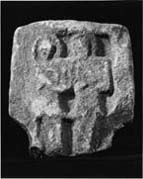Select a site alphabetically from the choices shown in the box below. Alternatively, browse sculptural examples using the Forward/Back buttons.
Chapters for this volume, along with copies of original in-text images, are available here.
Object type: Cross-arm
Measurements: H.24.2 cm (9.5 in); W. 21 cm (8.5 in); D. 10.8 cm (4.5 in)
Stone type: Coarse-grained, massive yellow sandstone
Plate numbers in printed volume: Pl. 6.21-24
Corpus volume reference: Vol 1 p. 45-46
(There may be more views or larger images available for this item. Click on the thumbnail image to view.)
Head, type A10 or A11.
A (broad): Surrounded by a wide flat-band moulding are two frontal figures possibly holding books. Their faces are oval and surrounded by haloes. Their shoulders, arms, and the hems of their knee-length tunics all touch.
B (narrow): A four-strand plain plait set in a narrow grooved moulding.
C (broad): A bird with displayed wings, standing on a perch, is framed in a wide flat-band moulding. Its head is turned, possibly pecking at a fruit or flower.
D (narrow): Two closed circuit loops set in a wide flat-band moulding.
The crudity of the carving clearly puts this cross, like the shaft fragments from the site, into the late Viking era. The iconography of this head, however, is derived from an early type, such as Ruthwell, in which the portraits of the Evangelists are on one side of the head, and their symbols on the other. The eagle is also in the uppermost arm of the cross-head at Ruthwell. However, this type of head continued in use into the ninth century as at Auckland St Andrew (no. 1), Hart (no. 7), and Halton, Lancashire (Cramp 1978b, 123), and seems to have been revived at Durham where there is a bird on the uppermost arm of 5. Hodgson (1906-11a, 18) compares this head with the Durham cross-heads, and indeed it is the same shape. However, this formula could just as well have been derived from Auckland St Andrew.



